Re: November
2002 issue of Classic Bike.
On page 65 you have a very interesting article on motor pacing at Herne
Hill. Our Cycling club is based there and our members would be very
interested in the article. Would it be possible for me to obtain
permission to copy said article to our website?
Mike Peel
Yes, you can put the
article on the website so long as Classic Bike is prominently credited: 'Feature
reproduced by permission of Classic Bike magazine - November 2002 issue'
Regards
Becky Cornell
Editorial Assistant

|
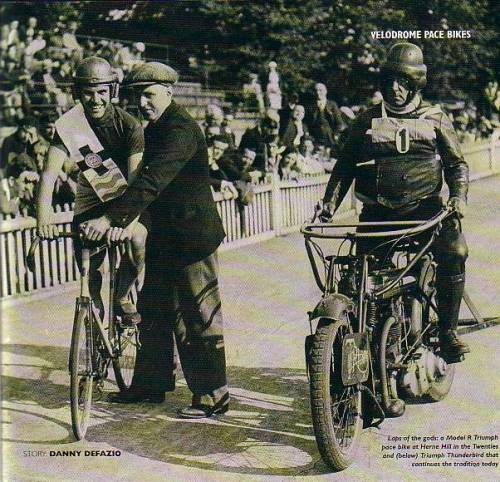
Laps of the gods: a model R Triumph pace bike at Herne Hill
in the Twenties and (below) Triumph Thunderbird that continues the
tradition today
|
Story by Danny Defazio
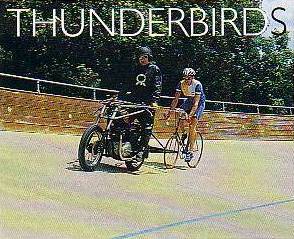 |
ARE STILL
GO
... but for how much longer? Modified TR65 Triumphs
are continuing a long tradition by acting as pace bikes for cycling racing
at the last velodrome in London. But its days may be numbered as the local
council threatens to wave the final chequered flag… |
When London staged the Olympic Games in 1948, more than
48,000 people packed into the Herne Hill Velodrome to watch the cycle track
disciplines. Fast forward 54 years and 1 am greeted by blank looks and the
shaking of heads when 1 ask directions to the venue that still stages cycle
events.
The evidently little known Herne Hill track, in south east
London, is the last remaining velodrome in the whole of the Greater London area
and the south east. And there is now a question mark over its future the local
council is undertaking various feasibility studies and there is talk of cycling
giving way to football. A final decision will be made in October, 2003.
So 1 had better get a move on. I am here in Herne Hill to
try out one of the ten 1982 Triumph TR65 Thunderbirds used as pace bikes.
Pace bikes in the sense that the ten Thunderbirds stay on
the track for the entire race, getting their pursuing charges up to racing speed
and then adjusting accordingly.
It makes for the extraordinary spectacle of up to ten
motorcyclists and ten cyclists haring around the velodrome, with the spoils
going to the first, hard-pedalling cyclist and Thunderbird 'driver', as the
Triumph riders are called, to cross the line.
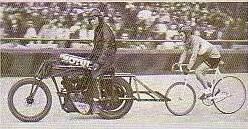 |
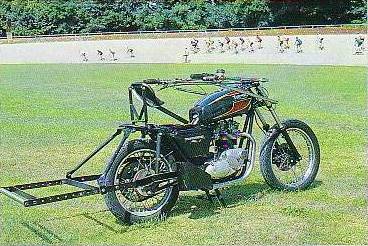 |
| Above:
Twenties velodrome action on the Continent
Right: frame with roller
prevents cyclists from jamming into the pace bike
Below: this heavyweight
machine in action on the Continent |
And a Thunderbird in the sense that, at first glance, the
machine 1 am given to try out certainly looks like a Thunderbird and,
notwithstanding the absence of any form of baffling, it sounds like a familiar
Meriden twin. But when you actually start to ride this adapted machine, you
quickly realise that a good part of what knowledge you have acquired about
motorcycling is of little use.
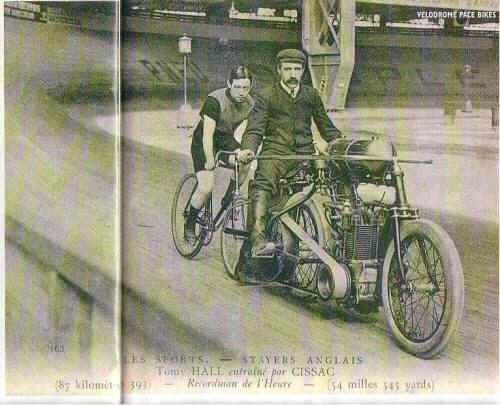 For
a start, you straddle the bike rather than sit on it. There isn't a seat...
well, not one worthy of its name. Instead, there is a rump shaped panel.
For
a start, you straddle the bike rather than sit on it. There isn't a seat...
well, not one worthy of its name. Instead, there is a rump shaped panel.
But then, with this machine you are forced to either stand
on the ground or on the footplates. Making the transition from one to the other
is the catch.
Fortunately I have 57 year old Colin Denman, one of the
three coaches at the track, as host for the day. He explains that the secret of
getting safely airborne is to have someone hold the back end of the bike and
give you a running start, while you perch on that absurd panel and work out
which way you are planning to wind the throttle. After all, you do have a
choice.
Professional pace riders know that every wisp of air
flowing beneath their underarms is literally a drag to the following cyclist,
which is why a crude mechanism allows them to turn the throttle in reverse. This
means that their arms are pinned tight against their, bodies.
However, when you are standing on the hot seat and hanging
on to those absurdly long handlebars, you revert to being a slave to convention
and wind up the throttle as normal anti clockwise. Thankfully this is only a
practice run. It would be a different ball game in competition.
Then, you suddenly notice that the gear lever is on
backward, so the sequence is one up, three down. As for fifth, forget it. It is
not on any of the bikes. Colin does not know why.
A short stroke (76 x 71.5mm) torquey twin, the 65Occ
machine is as forgiving as Hillary Clinton, and soon you are wobbling your way
to the first embankment. You could imagine them all sniggering behind on the
terraces but you are too busy trying to work out the laws of physics to worry
about image. The huge rear sprocket demands that you shift up rapidly, and soon
you and the bike are climbing the wall. Instantly, you begin to reappraise
gravity and realize just what a big baby you are.
| Triumph's sporting
links
Launched in 1981 two years before the collapse of
Meriden the Triumph Thunderbird was an economy 649ce motorbike, priced at
£200 less than the Bouneville. Only 400 machines were made and the marque
was largely forgotten until a mini revival of interest in recent years
(see the feature in December 2001 issue of CB).
The Thunderbirds are not the first Triumph links
with the sport. Way back in the twenties, ranks of pace bikes that can
best be described as Model R Roadsters were roaring round the velodromes
of Europe. leading generations of .
One of the more impressive sights must have been the
huge three litre V-twin Anzani-powered pace bike that enabled Leon
Vanderstuyft to set a 76mph speed record at the Montlhery circuit south of
Paris in 1925.
At the other end of the scale are the 90cc two
stroke Puch-engined Derny practice pace bikes that are still in regular
use today. |
It is surprisingly sticky and tractable up there, and now
the Thunderbird is roaring around the perimeter, seemingly finding its own
track.
The ride is firm to painful thanks to the considerable
vibration, and it feels as if you need to take a pipe wrench to the steering.
The problem could be the lack of rear shockers, but suspicion soon falls on the
gearing. Also, the extra unsprung weight cannot be helping and you are glad
there are not potholes on the track, otherwise you would be brought down fast.
By the end of the first lap, you are beginning to get the
hang of it. You are still wobbling like a Sumo wrestler but at 40mph plus, it is
not that noticeable.
There is no foot brake you would not be able to use one
standing up, as it would simply pitch you over the headstock. Instead, you have
two levers on the left handlebar. One is for the clutch, the other is the rear
brake that operates the standard Thunderbird drum. On the opposite side is a
familiar Lockheed master cylinder.
Not that you actually need brakes. Well, not when you are
out joyriding. But when there are ten pace bikes on the track as there sometimes
are, each being pursued by a sweaty and frantic rider hurtling close behind, a
totally different level of skill is required.
The Thunderbirds were housed originally at the Leicester
Velodrome and were supplied and converted by an unknown dealer for the 1982
British Cycling Federation world championships. When the Leicester track was
demolished, the bikes were tried at the Manchester Velodrome, but were too heavy
for the wooden track, so they were sent to Herne Hill, where they reside in
articulated truck containers.
The conversion from motorcycle to pace bike may look
clumsy, but it works and follows a style forged by a century of experience.
The rear angle Iron frame carries a roller to prevent the
cyclist from jamming into the pace bike. The roller is set at a regulation
distance, and the good paceman knows exactly how to keep his rider out of the
breeze and on the fastest line.
"It is quite a knack," admits Colin. "But
we are in constant contact simply by shouting at each other, and you develop
strategies to stay ahead."
Quite, but some would go further and say it is the paceman
who is the real lynchpin of the race. After all, any fool with a pair of huge
calves can pedal a pushbike. Guiding that same fool through a roaring melee of
eight equally determined teams is as much an art as a science.
| 'Batman' stars at the
velodrome
You might well ask why Colin Denham rides his
Tunderbird in fancy dress. In fact, it is not a Batman costume but a suit
made for the 1982 world championships. Never a sport that attracts
much money, and so the suits have yet to be replaced. The sport may
be short of cash but it is a tough sport. Speeds of 70mph are not
uncommon and there are tales of dirty tricks and sabotage, but acid
attacks on riders could be folklore. However, there have been
fatalities. During WW2 an RAF man fitted his own carburettor to a
pace bike and flew over the embankment, breaking his neck.
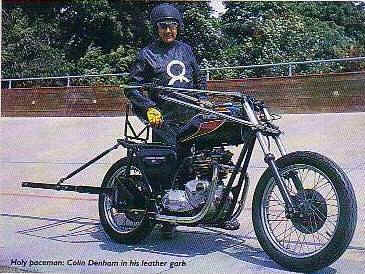 Colin
has had his share of injuries, including three broken ribs that resulted
in a three-month lay-off. "The biggest danger is a tyre
blow-out," he says. "These tyres, which are taped and
gluded to the rims, operate under enormous loads. One bike can, and
frequently does, bring down everything else behind it." Colin
has had his share of injuries, including three broken ribs that resulted
in a three-month lay-off. "The biggest danger is a tyre
blow-out," he says. "These tyres, which are taped and
gluded to the rims, operate under enormous loads. One bike can, and
frequently does, bring down everything else behind it."
Communication between driver and rider is
rudimentary. Intercoms were tried but aborted, so it is back to
shouting - "Allez" for Get on with it, and "Whoah!"
for slow down.
A cyclist since 1955 and a motorcyclist since not
long afterwards, Colin has a Category A British Cycling Federation licence
that allows him to ride anything on the track, and he keeps fit by cycling
50 miles a week. Now he fears for the future at Herne Hill.
Not only has there been no racing this year because of lack of riders but
there is the threat of a council redevelopment. |
|
Colin
Denman drove this 90cc two stroke to win the National Championship
this year with fellow Herne Hill coach Russell Williams |
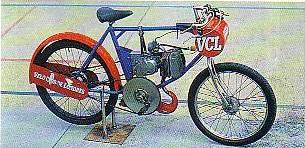 |
|

